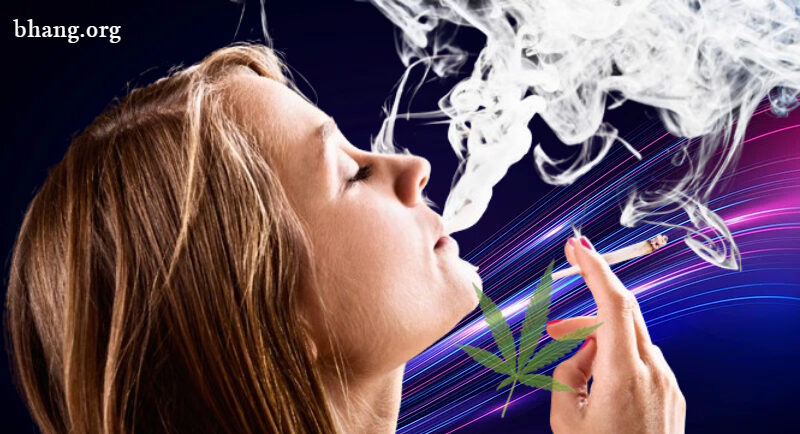Bhang and its Disadvantages: The dried leaves, flowers, stems, and seeds of the Cannabis sativa or Cannabis indica plant are commonly referred to as Bhang or smoking weed (Bhang). These plants contain THC, a psychoactive substance that alters perception, along with other related compounds. Cannabis can also be used to produce extracts.
Bhang is the most commonly used addictive drug, followed by alcohol and tobacco. It is particularly popular among young people, with over 11.8 million teenagers and young adults reported to have used Bhang in the year prior to 2018. While the number of children in grades 8 and 10 who report daily Bhang use has increased, overall usage among middle and high school students has remained stable in recent years, according to the Monitoring the Future survey.
The psychoactive component THC has gained popularity among teenagers, with 4% of 12th graders claiming daily use of THC due to the increasing acceptance of vaping products. Additionally, teenagers are increasingly less likely to perceive regular Bhang use as dangerous.
How Bhang is Used: Bhang and its Disadvantages
Aside from smoking through pipes and water pipes, Bhang is also consumed in hand-rolled cigarettes (joints) and in bongs. Blunts, which are emptied cigars filled with Bhang, are another common method. Some people opt for vaporizers to avoid inhaling smoke, which extract active compounds like THC and produce vapor instead. Liquid Bhang extracts are also used in some vaporizers.
Bhang can also be incorporated into various edibles such as tea, brownies, and cookies. Another emerging method is the consumption of THC-rich resins, either through smoking or ingestion.
Effects of Bhang on the Brain: Bhang and its Disadvantages
Short-term Effects
When Bhang is smoked, THC enters the bloodstream rapidly through the lungs and reaches the brain and other organs. The effects are felt more gradually when consumed orally or applied topically, typically within 30 to 60 minutes.
THC affects specific brain cell receptors that are sensitive to similar chemicals. Overactivation of these receptors, particularly in areas where they are abundant, leads to the sensation of being “high” and can cause altered perceptions, mood swings, impaired coordination, difficulty with problem-solving, memory impairment, hallucinations, delusions, psychosis, and distorted sense of time.
Long-term Effects
Bhang use, especially when initiated during adolescence, can impact brain development, affecting the connections between regions responsible for cognitive functions like thinking, memory, and learning. Research is ongoing to determine the duration and permanence of these effects.
Studies have shown that heavy Bhang use in adolescence may lead to a decline in IQ, with individuals experiencing an average loss of 8 IQ points by adulthood. This decline was not reversible in those who continued to struggle with Bhang use disorders. However, adults who ceased Bhang use did not exhibit significant IQ decreases. (Bhang and its Disadvantages)
Another study found that Bhang use during adolescence was associated with declines in verbal and general knowledge, but no differences were observed between twins when one used Bhang and the other did not. This suggests that factors other than Bhang, such as genetics and family environment, may contribute to IQ reduction.
The Adolescent Brain Cognitive Development program is conducting research to better understand how Bhang and other substances impact brain development during adolescence.
Benefits and Drawbacks of Smoking Weed (Bhang)
For thousands of years, people have utilized cannabis for both medicinal and recreational purposes.
Benefits of Smoking Weed (Bhang)
With more states legalizing Bhang for medical and recreational use, researchers have gained greater freedom to explore the potential benefits and drawbacks of the cannabis plant. This has led to increased interest and understanding of various cannabinoids and their potential medicinal uses. Let’s explore some of the most researched uses of cannabis:
- Reduces Inflammation
Inflammation is a common factor in various chronic conditions such as multiple sclerosis (MS), muscle spasms, epilepsy, glaucoma, Alzheimer’s disease, and others. CBD and other cannabinoids have been found to effectively reduce inflammation. A well-known study from 2010 demonstrated CBD’s efficacy in reducing inflammation.
- Alleviates Pain
Chronic pain significantly impacts quality of life and productivity, affecting individuals with conditions such as migraines, fibromyalgia, and neuropathic pain. Cannabis can provide relief from pain when applied topically or ingested orally, reducing the need for strong opioids and other medications that may have adverse effects. Access to medical cannabis has been associated with a decrease in the use of opioids and other drugs. According to the National Academies of Sciences, Engineering, and Medicine, there is substantial evidence supporting the use of cannabis and cannabinoids for chronic pain relief.
- Decreases Nausea
Nausea can be a debilitating symptom caused by various factors, including medical treatments like chemotherapy. Cannabis may alleviate nausea and improve appetite, making it easier for individuals to consume food. Research suggests that cannabinoids, particularly CBD and THCA, can be effective in managing nausea and vomiting. FDA-approved synthetic THC drugs like dronabinol and nabilone have been used to treat nausea and vomiting induced by chemotherapy and to stimulate appetite in AIDS patients.
- Helps Reduce Anxiety and Depression
Studies have shown that cannabis, when used in moderation, can reduce anxiety and improve mood. The specific strain, terpenes, and THC: CBD ratio may play a role in the anxiolytic effects of cannabis. While THC may reduce anxiety in low doses but increase it in higher doses, CBD has shown to consistently reduce anxiety without the intoxicating effects associated with THC. Combining THC and CBD may counteract some of the anxiety-inducing effects of THC. Cannabis use has been found to alleviate symptoms of anxiety and depression in clinically diagnosed populations.
- Improves Sleep Quality
Preliminary research suggests that CBD may be effective in treating insomnia, while THC may help individuals fall asleep faster but may impact sleep quality over time. Acute administration of cannabis has been shown to aid in falling asleep and increase Stage 4 sleep. However, further research is needed to fully understand the effects of cannabis on sleep.
Drawbacks of Smoking Weed (Bhang)
While cannabis offers potential benefits, it’s essential to acknowledge the potential drawbacks:
- Risk of Addiction: Some individuals may develop a dependence on cannabis, leading to addiction and withdrawal symptoms when attempting to quit.
- Impaired Cognitive Function: Long-term use of cannabis, especially during adolescence, may impact cognitive function, memory, and learning abilities.
- Mental Health Risks: Cannabis use may exacerbate or trigger mental health issues such as schizophrenia, psychosis, and mood disorders in susceptible individuals.
- Respiratory Issues: Smoking cannabis can lead to respiratory problems similar to those caused by smoking tobacco, including chronic bronchitis and lung irritation.
- Legal and Social Implications: Despite legalization in some areas, cannabis remains illegal in many regions, leading to potential legal consequences for possession and use. Additionally, social stigma surrounding cannabis use may impact relationships and employment opportunities.
Disadvantages of Smoking Weed (Bhang)
Recent studies have validated what many individuals have suspected for some time based on personal experiences: cannabis offers various medicinal and positive effects worthy of exploration. However, it’s essential to maintain an unbiased and objective viewpoint regarding cannabis use and its impacts on individuals. It’s crucial to acknowledge the genuine drawbacks and distinguish them from the prevalent negative stereotypes and misinformation that have circulated over the years. Let’s delve into some of the adverse health, societal, and legal effects of cannabis use.
- Impaired Memory
The notion that cannabis use can lead to short-term memory impairment is widely recognized. This effect may be particularly pronounced in young adults, whose prefrontal brains may not fully develop until around the age of 25. While there’s limited research on cannabis’s impact on cognitive function, some studies suggest that young adults who use cannabis before the age of 15 may be more susceptible to memory issues later in life. However, it remains unclear whether chronic cannabis use results in lasting cognitive deficits or if these effects are temporary.
- Lung Damage
Smoking, in any form, can lead to lung damage. Current evidence suggests that cannabis smoke may have similar effects on the lungs as tobacco smoke, resulting in symptoms such as increased coughing and hyperinflation. While there’s limited research comparing the links between cannabis and tobacco smoke and more serious conditions like lung cancer, long-term cannabis use has been associated with symptoms of chronic bronchitis. Additionally, cannabis smokers may inhale higher levels of carbon monoxide and tar compared to tobacco smokers, which could potentially impact cardiovascular health, particularly in vulnerable populations.
- Legal Discrepancies
The continued federal prohibition of cannabis in many states poses challenges to accessing and utilizing cannabis products effectively. Legal concerns may deter individuals from using cannabis as a treatment, fearing legal, professional, and criminal repercussions. Federal restrictions can also affect employment opportunities, as individuals may be disqualified from federal positions, even in states where cannabis is legal. Patients with medical cards may face restrictions on certain activities, such as obtaining a concealed carry permit. Moreover, purchasing cannabis from the black market in states with limited legal options poses risks of exposure to tainted products and challenges in obtaining accurate information about strains, growing methods, and cannabinoid profiles.
- Persistent Social Stigma
While drug policy reforms have led to some reduction in the societal stigma surrounding cannabis use, significant stigma persists, especially in areas where cannabis remains illegal for recreational or medical purposes. Historical stigmatization and criminalization of cannabis have been driven more by societal perceptions of the plant and its users than actual issues related to its use. Even with increased acceptance, cannabis users may still face stigma, leading to secrecy about their usage. Marginalized communities often face harsher stigma and penalties, such as job loss or legal repercussions, for cannabis use.
In summary, while cannabis offers potential benefits, it’s essential to recognize and address its drawbacks, ensuring that individuals can make informed decisions about its use while mitigating potential risks.
Conclusion:
Bhang and its Disadvantages, with its psychoactive compound THC, has been used for both medicinal and recreational purposes for thousands of years. While it offers potential benefits such as pain relief and reduced inflammation, it also poses drawbacks such as addiction risk and cognitive impairment. Understanding both the benefits and drawbacks of Bhang use is essential for making informed decisions about its consumption.
FAQs about Bhang and its Disadvantages
What is Bhang?
Bhang, also known as weed or cannabis, refers to the dried leaves, flowers, stems, and seeds of the Cannabis sativa or Cannabis indica plant. It contains THC, a psychoactive compound that alters perception, along with other related compounds.
How is Bhang used?
Bhang can be smoked through pipes, water pipes, hand-rolled cigarettes (joints), or emptied cigars filled with Bhang (blunts). Vaporizers can also be used to inhale vaporized Bhang extracts. Additionally, Bhang can be infused into various edibles such as brownies, cookies, and tea.
What are the short-term effects of Bhang on the brain?
When smoked, THC enters the bloodstream rapidly, affecting specific brain cell receptors and leading to sensations of being “high.” Short-term effects include altered perception, mood swings, impaired coordination, difficulty with problem-solving, memory impairment, hallucinations, and psychosis.
What are the long-term effects of Bhang use?
Long-term Bhang use, especially when initiated during adolescence, may impact brain development, leading to cognitive deficits and memory problems. Studies suggest that heavy Bhang use in adolescence may result in a decline in IQ, with effects persisting into adulthood.
What are the benefits and drawbacks of smoking weed (Bhang)?
Bhang has been associated with benefits such as reducing inflammation, alleviating pain, decreasing nausea, reducing anxiety and depression symptoms, and improving sleep quality. However, drawbacks include the risk of addiction, impaired cognitive function, respiratory issues, legal discrepancies, and persistent social stigma.





Leave a Reply